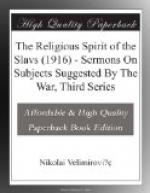SLAV ORTHODOXY IS NOT SELF-SUFFICIENT.
We are quite conscious that our religion is not solely Christ’s work. Every drop of blood of a Christian martyr is a stone in the work. Every suffering man with heroic Christian hopes, and every dying human being with optimistic Christian belief is a collaborator of Christ, or is a founder of our Church. The Church is not at all solely Christ’s work, she is the collective work of many and many millions who, in the name of Christ, decisively took part in this mystic race of earthly life. That is just what Christ wanted and prophesied. That is why He washed the feet of His disciples.
The work of Tolstoi is the work of a man; Slav Orthodoxy is the work of the generations. Orthodoxy was first defined by the Christian Jews and Greeks during the first eight hundred years. During the other thousand years Orthodoxy was enriched by the Slav Bible, i.e., by Slav religious experiences, by Slav martyrs, saints, heroes, by Slav sins and repentances, by Slav struggles and convulsions for Christ. It is a very large record, a very large Bible indeed, a wonderful drama, quite new, fresh, original, although in old forms and words, and signs. Still Slav Orthodoxy is not self-sufficient. She would become by human inertia self-sufficient, unless Providence sent her punishment from time to time. Tolstoi was for Orthodoxy a punishment. He was like a whirlwind which pulls down many things but at the same time purifies the unhealthy air. He was not at all a demon, but a man sent by God to help our Church; and he helped very much indeed—as all the sects and critics of Christianity from the beginning have helped the Christian cause, ridiculing and exposing the Christian Paganism manifested in ecclesiastical pride, in superstitions, prejudices, intolerance, etc.




